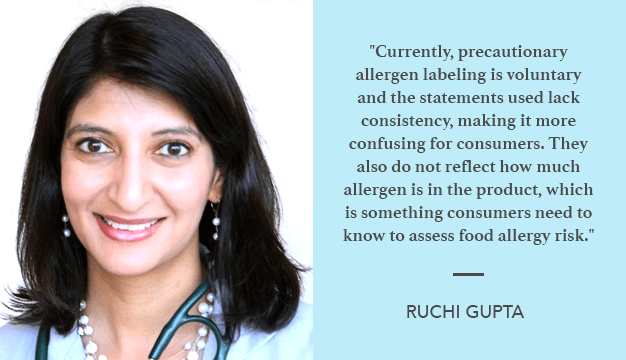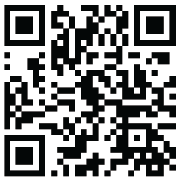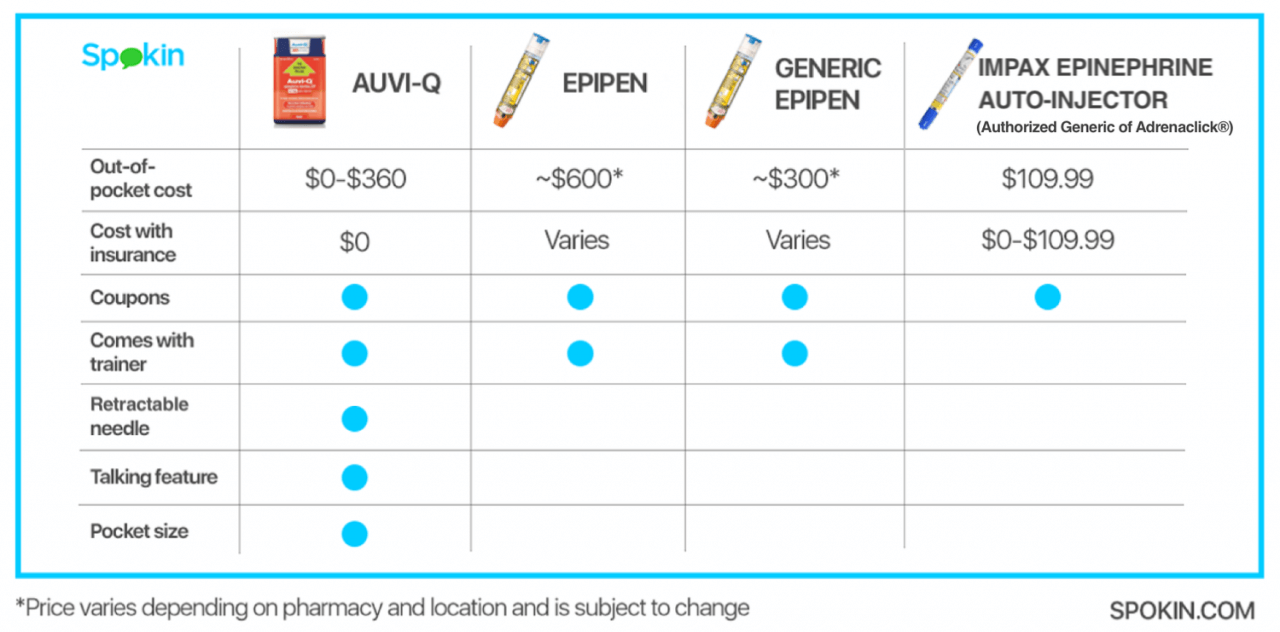Learning how to read a food label to avoid your allergens is essential to eating safely. This vital skill isn’t only for the newly diagnosed as label reading never ends. Dr. Ruchi Gupta, a leading researcher in food allergies, shares that even experienced food allergic families need clarity based on her recently published study “Food Allergen Labeling and Purchasing Habits.”
Her eye-opening work centered on precautionary allergen statements, the labels that warn consumers of potential undeclared allergens (ones that accidentally get into the food.) Dr. Ruchi Gupta’s key findings are that these precautionary allergen statements that we rely on are causing confusion. Up to 40% of us are buying food items with precautionary labels, so here is what you need to know:
✔️ These labels are not required. Almost half of consumers believed that this type of food labeling is required by law, this is not the case.
✔️ There are many variations of wording used in these labels but the different wording does not indicate the likelihood or the potential amount of the allergen. 1 in 3 consumers falsely believed that precautionary allergen statements are based on the amounts of allergen in the product.
If you make a choice whether or not to consume food based on the wording of the warning label, please understand that these labels are not regulated and there are no standards that food manufacturers rely on to determine the wording that they use.
Yes, it’s complicated but let’s simplify.
The basics:
You need to avoid foods that contain your allergens and foods that accidentally contain your allergen, often referred to as cross contamination or cross contact.
Step 1: Understand how and where to find allergen information on a label
If your allergen is a Top 8:
The Food Allergen Labeling, Consumer Protection Act, requires by law, that packaged foods list an allergen in plain english if it is an ingredient. This only is required if the allergen is one of the top 8 which include peanut, tree nut, milk, eggs, wheat, soy, fish, and shellfish.
There are 3 ways the allergens can be listed on the label:
1. The allergen can be listed within the ingredients list.
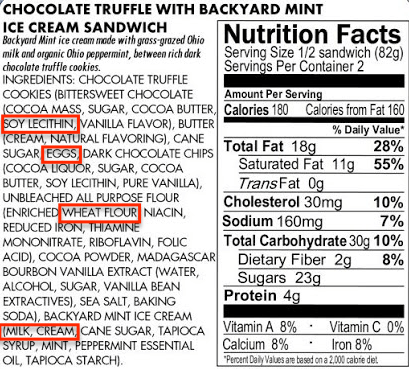
2. The allergen can be listed in parenthesis after the scientific name for the ingredient or an ingredient which is made up of other ingredients. For example, the ingredient “whey” must be listed as “whey (milk)”.
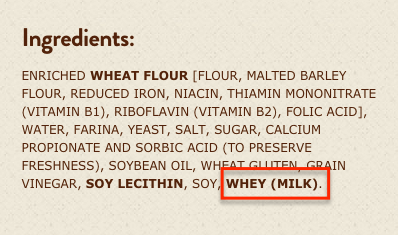
3. The allergen can also be listed in a “contains” statement listed either immediately after or adjacent to the list of ingredients. It should be in type size that is no smaller than the type size used for the list of ingredients.
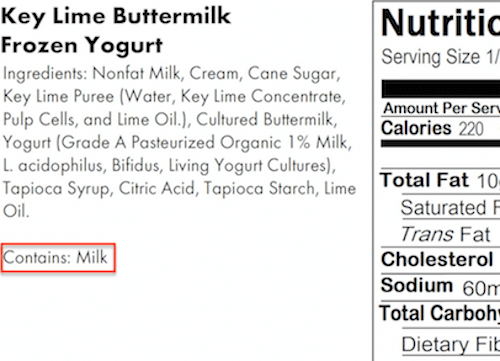
If your allergen is not one of the top 8:
Manufacturers are not required to declare the allergen unless they are in the top 8; this requires more work for consumers to stay safe.
Read ingredient lists carefully and become familiar with the scientific names for your allergen so you are able to identify them in their various forms. Familiarize yourself with common hiding places for your allergen. Allergic Living magazine and FARE have great resources for hidden allergies.
Spices and colorings can also contain allergens but only the top 8 are required to be listed. Call the manufacturer to determine if your allergen is in the spice or coloring.
Step 2: Understand cross contamination and know where to find label warnings
Cross contamination or cross contact is when a food allergen accidentally gets into food. It is typically in small amounts and can be difficult to detect. Manufacturers often use precautionary statements to warn consumers of potential risks in certain food products. Examples include:
- “May contain traces of peanut and tree nuts”
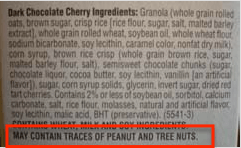
- “Manufactured on equipment that also processes peanuts”
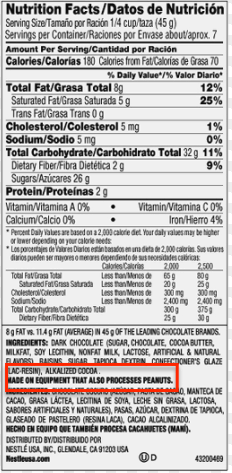
- “Processed in a facility that processes peanuts, tree nuts, soy, wheat, and dairy products”
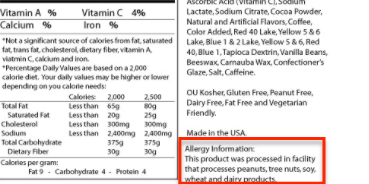
Need to know on warning labels:
- These warning labels are NOT required by law and are therefore unregulated and unverified
- The different phrases are not indicative of amount of allergens in the food and so cannot be used to measure the risk of exposure.
Precautionary labeling, although done with the best intentions, has caused a lot of confusion for consumers. Ruchi’s study of cookies and chocolate labels found over 25 different types of wording for precautionary allergen labels.
The majority of consumers are influenced by the language used in these unregulated warnings. There is no indication that one precautionary statement is safer than another and putting trust in one over another is not advised.
Step 3: Go the extra mile
3 Additional ways to learn more:
- Reach out to the manufacturer: If you are not comfortable or unsure of the meaning of a label, the manufacturer’s website often includes additional details. Look for allergen information or FAQs sections. You can also call the manufacturer directly.
- Sign up for Food Allergy Recalls: Accidents happen and thankfully, the FDA releases food allergy recalls and warnings for undeclared allergens. Sign up for FDA alerts to receive emails directly.
- Be aware of changes: Ingredients in products and/or the manufacturing process can change at any time. The best defense is to read labels each and every time before consuming.
4. Conclusion
Ruchi aptly points out there is a clear need for regulation and standardization of the precautionary allergen statements in order for consumers to make safe choices with confidence. We agree and we will keep our Spokin readers in the know and informed on this issue.
Resources:
- “Food Allergen Labeling and Purchasing Habits” By Dr. Ruchi Gupta
- FDA Food Recalls
- Allergic Living Magazine: Hidden Allergens
- FARE: Hidden Allergens

